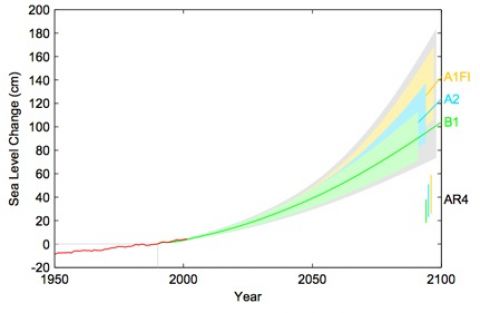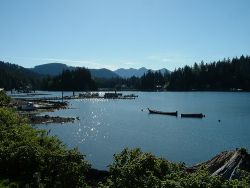A sobering new projection of sea-level rise published last week in the prestigious American journal Proceedings of the National Academy of Sciences reminds us yet again of what world leaders need to accomplish today in Copenhagen, and why.
The new paper from Martin Vermeer and Stefan Rahmstorf, Global sea level linked to global temperature, uses an improved method to project changes in sea level up to 2100 under different global warming scenarios. The scientists use a formula built on the observed (i.e., real-life) relationship between sea level and global average surface temperature over the past several decades, allowing them to project the response of sea level to temperature in the 21st century. To ensure that their method is accurate, they compare the results it gives to the observed values for sea level from the historical record. The match-up is startling, producing a 98% correlation between real life observations and what the model predicts.
The really scary news is that their projections are roughly triple those of the Intergovernmental Panel on Climate Change (IPCC)'s most recent report. Sea level rise was already one of the most serious impacts of climate change; now the most up-to-date science suggests that it's likely to be about three times more serious than we thought. For a more detailed explanation of the difference, see my appendix post Understanding Ice Sheets.

FIGURE: New research estimates sea-level rise will be triple IPCC's projections by 2100. Source: Vermeer and Rahmstorf, 2009.
Urgent Action Required
This new research, consistent with other recent attempts to provide more accurate projections of sea level rise, finds that without urgent action on emissions, sea levels will rise by 80-180cm by the end of this century. The averages for different warming scenarios run from about 1m to about 1.5m by 2100. After that, seas will still continue rising because of time lags in the climate system and because tipping points on major ice sheets may be crossed, leading to sustained melting over several centuries. Stable coastlines may not be established for many centuries, making it very difficult to relocate critical infrastructure like ports.
Of course, sea level rise is not a sudden event but a creeping problem that continues inexorably. It doesn't take much imagination to picture the global consequences of this.
According to an estimate cited by the UN Environment Program's 2009 climate science compendium,"for every 20cm of sea-level rise the frequency of any extreme sea-level of a given height increases by a factor of about 10." In other words, "by 2100, a rise of sea level of 50cm would produce events every day that now occur once a year and extreme events expected once during the whole of the 20th century will occur several times every year by the end of the... 21st."
Just imagine what that would mean for a rise of one metre or more.
Which brings us back here, to Copenhagen. The global climate deal that Stephen Harper and his peers are negotiating here today will decide the scale of impacts the world is committed to for the rest of this century. It is now clear that the weak pledges currently on the table add up to a world with well over 1m or more of sea level rise within this century.
 This explains why countries like Tuvalu have taken such a strong stand here in Copenhagen. Their survival is on the line. With that much sea level rise, many small-island states will simply disappear. And it's not just about small nations. Countries like Bangladesh, Egypt and Vietnam have tens of millions of citizens living at less than 1m above current sea level. Preventing massive displacement of populations requires immediate and urgent emissions reductions.
This explains why countries like Tuvalu have taken such a strong stand here in Copenhagen. Their survival is on the line. With that much sea level rise, many small-island states will simply disappear. And it's not just about small nations. Countries like Bangladesh, Egypt and Vietnam have tens of millions of citizens living at less than 1m above current sea level. Preventing massive displacement of populations requires immediate and urgent emissions reductions.
Vermeer and Rahmstorf note that "likely [the reductions] would have to be deeper than those needed to limit global warming to 2°C, the policy goal now supported by many countries. Our analysis further suggests that emissions reductions need to come early in this century to be effective." Hence the slogan of AOSIS, the negotiating block for the Alliance of Small Island States: "1.5˚C to stay alive."
A Mari Usque Ad Mare
 Findings like these should provoke some soul searching from Canada with regards to its own level of ambition. Notwithstanding the implications of tens or even hundreds of millions of climate refugees, sea level rise will also have serious impacts on our own shores.
Findings like these should provoke some soul searching from Canada with regards to its own level of ambition. Notwithstanding the implications of tens or even hundreds of millions of climate refugees, sea level rise will also have serious impacts on our own shores.
As is suggested by our motto, we are a maritime nation. We are also extremely vulnerable to rising seas. According to the federal government's 2008 report, From Impacts to Adaptation — the most comprehensive assessment yet done on the consequences of climate change in Canada — sea levels on Canadian coasts are predicted to rise at rates greater than the global average, increasing risks of coastal flooding and bringing more frequent and severe storm surges and rapid erosion. The regions most at risk include much of Atlantic Canada (coastal PEI, Nova Scotia and New Brunswick), the Beaufort Sea coast and the Fraser River Delta.
In this context, it's surprising that Environment Minister Jim Prentice's entourage of eminent advisors in Copenhagen doesn't include a climate scientist who could advise the minister on the consequences for Canada of the decisions being made here.
Staying on the Map
 There's a giant globe in the conference centre here in Copenhagen. After a day or so, people realized that its stylized world map does not even show most small island states. Delegates have had to add their homelands to the map in handwritten letters and blue ink.
There's a giant globe in the conference centre here in Copenhagen. After a day or so, people realized that its stylized world map does not even show most small island states. Delegates have had to add their homelands to the map in handwritten letters and blue ink.
Low-lying nations like Tuvalu and the Maldives tell us that "survival is not negotiable." And it shouldn't be.
For now, those islands are still here. Now is the time to save them.
P.J. Partington was a senior analyst with the Pembina Institute's federal policy group until 2015.



